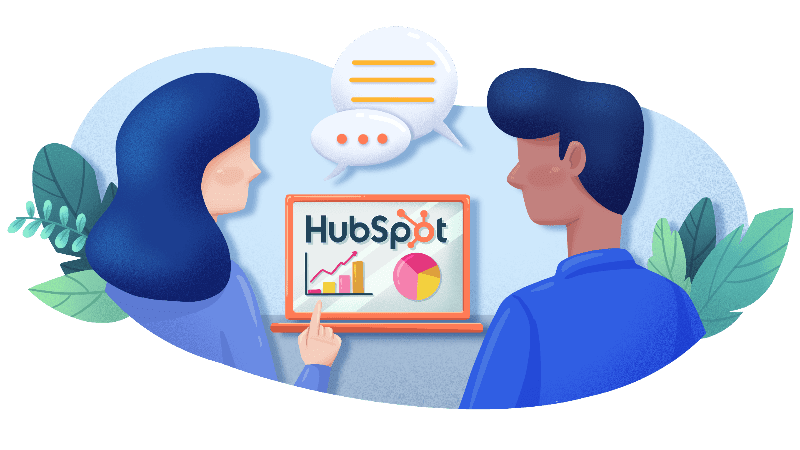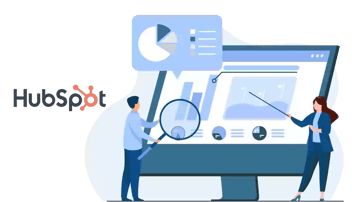What are HubSpot Playbooks, and How Can I Use Them?
Consistency is key in the world of effective sales and marketing. Whether you're nurturing leads, closing deals, or providing customer support, having a standardized approach ensures that your team is operating at peak efficiency. That's where HubSpot Playbooks come in.

This powerful tool allows you to create and share step-by-step guides for common sales and marketing processes. With playbooks, you can equip your team with the knowledge and resources they need to deliver exceptional results consistently.
What are HubSpot Playbooks?
Imagine having a centralized repository of best practices, templates, and resources, easily accessible to your team whenever they need it. That's what HubSpot Playbooks offer.
Playbooks in HubSpot are interactive content cards that can be attached to contact, company, deal, and ticket records within your HubSpot CRM. On Enterprise tiers, they are also available on Custom Objects. They are a centralized repository for best practices, templates, and other resources, guiding your team through various sales and marketing scenarios.
HubSpot Playbooks aren't confined to a singular function. Instead, they encompass a versatile range of applications. From facilitating routine tasks in sales processes or sales meetings to orchestrating complex marketing campaigns, creating a playbook helps empower businesses across industries. Plus, they can help you simplify maintaining your CRM database.
Key components:
-
Triggers: Initiating events that set the playbook into motion. Triggers can be diverse, ranging from a lead reaching a specific stage to a customer interaction on your website.
-
Actions: The series of steps and tasks executed once a trigger is activated. This can include sending emails, updating contact records, assigning tasks to team members, or even initiating follow-up sequences.
-
Conditions: Customizable criteria determining when a playbook should or should not run. Conditions add a layer of specificity, ensuring that playbooks respond intelligently to various scenarios.
-
Branching logic: A decision-making element within the playbook that directs the workflow based on specific conditions or criteria. This ensures a personalized and targeted approach in your marketing endeavors.
The advantages of implementing HubSpot Playbooks are numerous:
-
Standardized processes: Eliminate discrepancies in approach and ensure a consistent customer experience by establishing standardized processes.
-
Enhanced efficiency: Streamline workflows and reduce time spent searching for information with step-by-step instructions and readily available resources.
-
Effortless onboarding: Quickly bring new hires up to speed by providing them with a valuable training tool that outlines your team's processes and best practices.
-
Consistent customer experience: Foster positive brand relationships by ensuring every customer interaction is handled professionally and consistently.
-
Data-driven decision-making: Make informed decisions based on valuable insights into team performance and process effectiveness.
How to Use Playbooks in HubSpot
Having grasped the fundamentals of HubSpot Playbooks, it's time to explore their remarkable versatility. While initially conceived as a tool to optimize military or sports processes, the playbooks tool has evolved into an indispensable asset across various facets of business operations.
Lead Generation
HubSpot Playbooks are potent catalysts for lead generation, providing a systematic approach to identifying, nurturing, and converting prospects into valued customers. By automating lead scoring, sending targeted emails, and triggering personalized follow-ups based on user behavior, these playbooks empower your marketing team to optimize their efforts efficiently.
Example: Imagine a potential lead downloads a whitepaper from your website; with HubSpot Playbooks, an automated sequence can be triggered, delivering a series of tailored emails, guiding the lead through the sales funnel.
Sales Enablement
Sales teams stand to gain immensely from the integration of HubSpot Playbooks into their workflows. Playbooks facilitate smoother communication by automating routine tasks, allowing sales representatives to focus on high-impact activities. From outreach to closing deals, these playbooks ensure a cohesive and strategic approach throughout the sales cycle.
Example: A sales playbook can be designed to automate follow-up emails, schedule calls, and update lead status based on their engagement, ensuring that sales reps are always engaging with leads at the right time and with the most relevant information.
32% of sales teams report increased efficiency after implementing HubSpot Playbooks.
Customer Service Enablement
Beyond customer acquisition, HubSpot Playbooks are pivotal in fortifying customer relationships. By automating responses to common queries, initiating customer feedback surveys, and proactively addressing potential issues, these playbooks contribute to an elevated customer service experience.
Example: In the event of a customer submitting a support ticket, a playbook can be triggered to acknowledge the request, provide initial troubleshooting steps, and seamlessly assign the ticket to the appropriate support agent, ensuring a prompt and organized resolution process.
45% of marketing teams report improved customer satisfaction after adopting HubSpot Playbooks.
Onboarding Processes
One often-overlooked application of HubSpot Playbooks is in the realm of onboarding. Whether you're onboarding new clients or guiding new employees through orientation, playbooks can be tailored to provide a seamless and personalized experience. Automated welcome emails, instructional guides, and scheduled check-ins can all be orchestrated to enhance the onboarding journey.
Example: For a SaaS company, playbooks can be used to guide new users through the onboarding process, sending automated tutorials and gathering feedback at strategic intervals to ensure a smooth transition into using the product.
Employee Training and Development
Internally, HubSpot Playbooks can be applied to facilitate employee training and development initiatives. By automating the delivery of training materials, quizzes, and performance assessments, playbooks contribute to a more streamlined and engaging training process.
Example: An HR playbook can be established for the onboarding of new employees, automating the distribution of training modules, scheduling mentorship sessions, and gauging employee satisfaction throughout the onboarding journey.
How to Create Playbooks
The process of creating HubSpot Playbooks is straightforward and can be effectively implemented by any team using these steps:
1. Create a new playbook
-
-
Navigate to the Sales > Playbooks section in your HubSpot account.
-
Click the "Create playbook" button in the top right corner.
-
Select the type of playbook you want to create: Sales or Service. You can choose a template or start from scratch.
-
2. Name your playbook
-
-
Click the pencil icon at the top of the page and enter a concise and descriptive name for your playbook.
-
This name should indicate the purpose of the playbook and the scenario it addresses.
-
Click "Create playbook."
-
3. Add playbook content
-
-
Start adding content to your playbook using the Content blocks.
-
Choose from a variety of content blocks, including:
-
Text blocks: Add text explanations, instructions, or notes.
-
Videos: Embed YouTube or Vimeo videos for visual guidance.
-
Images: Insert images to enhance comprehension and provide visual examples.
-
Links: Add links to relevant resources, such as templates, guides, or documentation.
-
Emails: Include sample email templates for specific scenarios.
-
Scripts: Provide sales scripts for effective customer interactions.
-
Question blocks: Engage your team with interactive questions and quizzes.
-
-
4. Structure your playbook
-
-
Divide your playbook into logical sections using Steps.
-
Each step should represent a distinct action or stage within the overall scenario.
-
Use descriptive step titles and clear instructions for each step.
-
5. Attach templates and resources
-
Associate relevant templates, such as emails, meeting agendas, or sales scripts, with the appropriate steps in your playbook.
-
Include links to helpful resources, such as product guides, pricing information, or customer support documentation.
6. Assign playbook visibility
-
-
Determine who should have access to your playbook.
-
Select the appropriate visibility level:
-
Everyone: All HubSpot users in your account can view and use the playbook.
-
Selected teams: Only specific teams can view and use the playbook.
-
Individuals: Only specific individuals can view and use the playbook.
-
-
7. Preview and publish
-
-
Preview your playbook to ensure it flows smoothly and provides the necessary guidance.
-
Once satisfied, click the Publish button to make your playbook available to your team.
-
Note: To create, edit, and delete HubSpot playbooks, you will need a HubSpot Sales Hub Pro or Enterprise or HubSpot Service Hub Pro or Enterprise seat.
Elevate Your Business Using HubSpot Playbooks
The power of HubSpot Playbooks is nothing short of revolutionary. From streamlining lead generation and sales enablement to orchestrating seamless onboarding experiences and enhancing customer service, the applications are as diverse as they are impactful.
By understanding and harnessing the potential of HubSpot Playbooks, businesses can redefine their approach to automation, injecting a personalized touch into every interaction. The journey doesn't end here; it extends to creating tailored playbooks that align precisely with your business goals.
Ready to get started? Our team of HubSpot-certified team members are here to help!
This content is also available in:
- German: Was sind HubSpot Playbooks, und wie kann ich sie verwenden?
- Spanish: ¿Qué son los Playbooks de HubSpot y cómo puedo utilizarlos?
- French: Que sont les HubSpot Playbooks et comment les utiliser ?
- Italian: Cosa sono i Playbook di HubSpot e come posso usarli?
- Romanian: Ce sunt playbook-urile HubSpot și cum le pot utiliza?
- Chinese: 什么是 HubSpot Playbooks,如何使用?









Leave a Comment